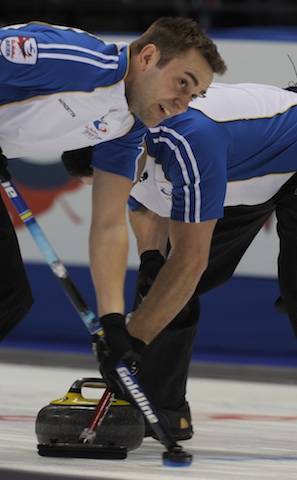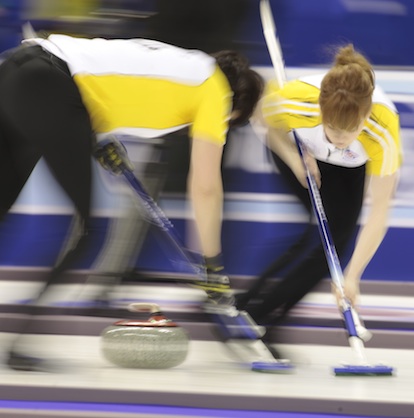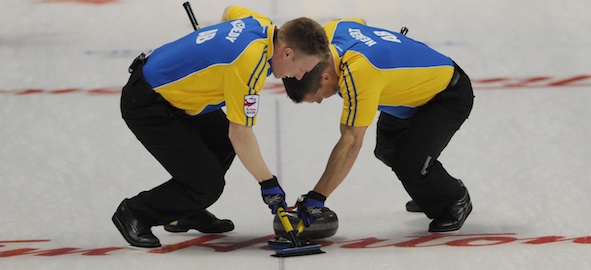House Call: Six Ways to Be a Better Sweeper
I have been asked many times if sweeping actually makes a difference or if it’s just a giant conspiracy to keep the players who aren’t throwing or skipping busy. The truth is this – sweeping can make a huge difference if it is done with proper technique. Unfortunately sweeping is often dismissed as something not worth practicing and some players do not develop the skills needed to be truly effective.
I cannot emphasize enough how much improving sweeping skills can add to your team’s overall shot-making ability. That’s right; you need to make shots as a team and the sweeping is just as important as the throwing and the skipping. By using the following six tips you can take your team to a whole new level of awesome!
 1. Start Close and Stay Close – Do NOT wait at the hogline to start sweeping. It is perfectly legal to stand nice and close to the thrower. I usually suggest starting at the T-line closest to the thrower. This way you can make sure you and the thrower both know what the shot is and what weight is expected. You’ll also have a clear view of whether or not the thrower should happen to push the stone or pull it back.
You may be wondering how you’ll possibly keep up to the stone if you start that close. Here is the trick: when you see the thrower begin their backward motion, you start to walk and you continue to stay with the thrower as he or she slides.
Remember to stay close to the stone all the way, even if it’s too heavy or obviously not going to make the requested shot. Your skip may have an alternate shot idea and if you’ve already given up and walked away, there’s less chance of sweeping to make plan B, C, or even D.
2. Communicate, Communicate, And Communicate – As soon as the stone is released, call out your best guess on where it’s going to end up immediately, loud and proud, and make sure the skipper can hear you. Sure, you might be wrong… in fact I guarantee you’ll be wrong more than once. The key is to keep giving your skip updates on the weight as the stone moves toward the other end. The more you practice guessing the weight and calling it out, the better you’ll get. Being a good judge of weight is an invaluable skill. Remember it takes time to develop this instinct so be patient and stick with it.
3. Look Up Often – It’s really easy to sweep like crazy because a stone is supposedly light, only to watch it sail out the back of the house. Looking up to see how fast the house is coming up is a great way to judge if you need to keep givin’ it all you’ve got or if you can let up a little. Think of looking up like taking a breath (breathing is something you should also remember to do when you sweep). You may find it easier to agree with your sweeping partner that the sweeper further away from the stone is the one who looks up. Just remember to share the information with your sweeping partner and skip, especially if you discover you need to stop or start sweeping.
4. Put Some Pressure On – Sweeping works by breaking down the pebble (bumps on the ice) to make a slicker surface for the rock to travel on. In order to effectively break down the pebble, friction is required. If you’re not putting enough pressure on your broom you may not be creating enough friction to be effective. Think about trying to force all of your body weight down on to the brush. It helps to get your head over top of the brush head.
You can test your pressure by borrowing a hair broom. Try sweeping as you normally would with it. Do all the hairs on the brush spread out nice and evenly and wide when you push down and stay that way as you sweep down the ice? If not, add more pressure until you get the hairs to spread out. If you go back to a synthetic head or if you keep using hair (either is perfectly fine by the way; you should use whatever you find most comfortable) remember the amount of pressure you needed to spread the hairs and try to push that hard all the time.
5. Keep Sweeping Strokes and Tight and Quick – Remember you only need to sweep the running surface of the stone to be effective. You can use the surface area of the rock handle as a guide. If you are sweeping wider than the width of the handle you can afford to tighten your strokes. Keep your stokes tight and quick and you’ll soon see an improvement in your overall effectiveness.
Sweeping is not supposed to be a walk in the park. After sweeping as hard as you can to the far end you should absolutely be out of breath… a lot. Here’s your chance to get a great workout every game. And if you think you can sweep harder, do it! You don’t want to have to question if you could have dragged a rock to the button instead of the eight-foot.
6. Sweep in Front of the Rock – This seems as if it should be obvious, but you’d be amazed if you knew how many curlers are awesome sweepers but completely ineffective! Take a look around at the other sweepers next time you play, and within moments, I bet you’ll see someone not sweeping in front of the rock.
Often it is hard to tell if you are not sweeping in front of the rock. Ask your skip to let you know (gently and quietly of course) if you happen to stray from the path of the stone.
Sweeping is fun and challenging and a great way to stay in shape. If you can incorporate any of these tips into your game I think you’ll be surprised by how quickly you start to see results. These six strategies combined are a wonderful secret weapon for any team to possess.
1. Start Close and Stay Close – Do NOT wait at the hogline to start sweeping. It is perfectly legal to stand nice and close to the thrower. I usually suggest starting at the T-line closest to the thrower. This way you can make sure you and the thrower both know what the shot is and what weight is expected. You’ll also have a clear view of whether or not the thrower should happen to push the stone or pull it back.
You may be wondering how you’ll possibly keep up to the stone if you start that close. Here is the trick: when you see the thrower begin their backward motion, you start to walk and you continue to stay with the thrower as he or she slides.
Remember to stay close to the stone all the way, even if it’s too heavy or obviously not going to make the requested shot. Your skip may have an alternate shot idea and if you’ve already given up and walked away, there’s less chance of sweeping to make plan B, C, or even D.
2. Communicate, Communicate, And Communicate – As soon as the stone is released, call out your best guess on where it’s going to end up immediately, loud and proud, and make sure the skipper can hear you. Sure, you might be wrong… in fact I guarantee you’ll be wrong more than once. The key is to keep giving your skip updates on the weight as the stone moves toward the other end. The more you practice guessing the weight and calling it out, the better you’ll get. Being a good judge of weight is an invaluable skill. Remember it takes time to develop this instinct so be patient and stick with it.
3. Look Up Often – It’s really easy to sweep like crazy because a stone is supposedly light, only to watch it sail out the back of the house. Looking up to see how fast the house is coming up is a great way to judge if you need to keep givin’ it all you’ve got or if you can let up a little. Think of looking up like taking a breath (breathing is something you should also remember to do when you sweep). You may find it easier to agree with your sweeping partner that the sweeper further away from the stone is the one who looks up. Just remember to share the information with your sweeping partner and skip, especially if you discover you need to stop or start sweeping.
4. Put Some Pressure On – Sweeping works by breaking down the pebble (bumps on the ice) to make a slicker surface for the rock to travel on. In order to effectively break down the pebble, friction is required. If you’re not putting enough pressure on your broom you may not be creating enough friction to be effective. Think about trying to force all of your body weight down on to the brush. It helps to get your head over top of the brush head.
You can test your pressure by borrowing a hair broom. Try sweeping as you normally would with it. Do all the hairs on the brush spread out nice and evenly and wide when you push down and stay that way as you sweep down the ice? If not, add more pressure until you get the hairs to spread out. If you go back to a synthetic head or if you keep using hair (either is perfectly fine by the way; you should use whatever you find most comfortable) remember the amount of pressure you needed to spread the hairs and try to push that hard all the time.
5. Keep Sweeping Strokes and Tight and Quick – Remember you only need to sweep the running surface of the stone to be effective. You can use the surface area of the rock handle as a guide. If you are sweeping wider than the width of the handle you can afford to tighten your strokes. Keep your stokes tight and quick and you’ll soon see an improvement in your overall effectiveness.
Sweeping is not supposed to be a walk in the park. After sweeping as hard as you can to the far end you should absolutely be out of breath… a lot. Here’s your chance to get a great workout every game. And if you think you can sweep harder, do it! You don’t want to have to question if you could have dragged a rock to the button instead of the eight-foot.
6. Sweep in Front of the Rock – This seems as if it should be obvious, but you’d be amazed if you knew how many curlers are awesome sweepers but completely ineffective! Take a look around at the other sweepers next time you play, and within moments, I bet you’ll see someone not sweeping in front of the rock.
Often it is hard to tell if you are not sweeping in front of the rock. Ask your skip to let you know (gently and quietly of course) if you happen to stray from the path of the stone.
Sweeping is fun and challenging and a great way to stay in shape. If you can incorporate any of these tips into your game I think you’ll be surprised by how quickly you start to see results. These six strategies combined are a wonderful secret weapon for any team to possess.

B.C.’s Kevin Folk takes a look. “Looking up to see how fast the house is coming up is a great way to judge if you need to keep givin’ it all you’ve got or if you can let up a little.” (Photo CCA/Michael Burns)






